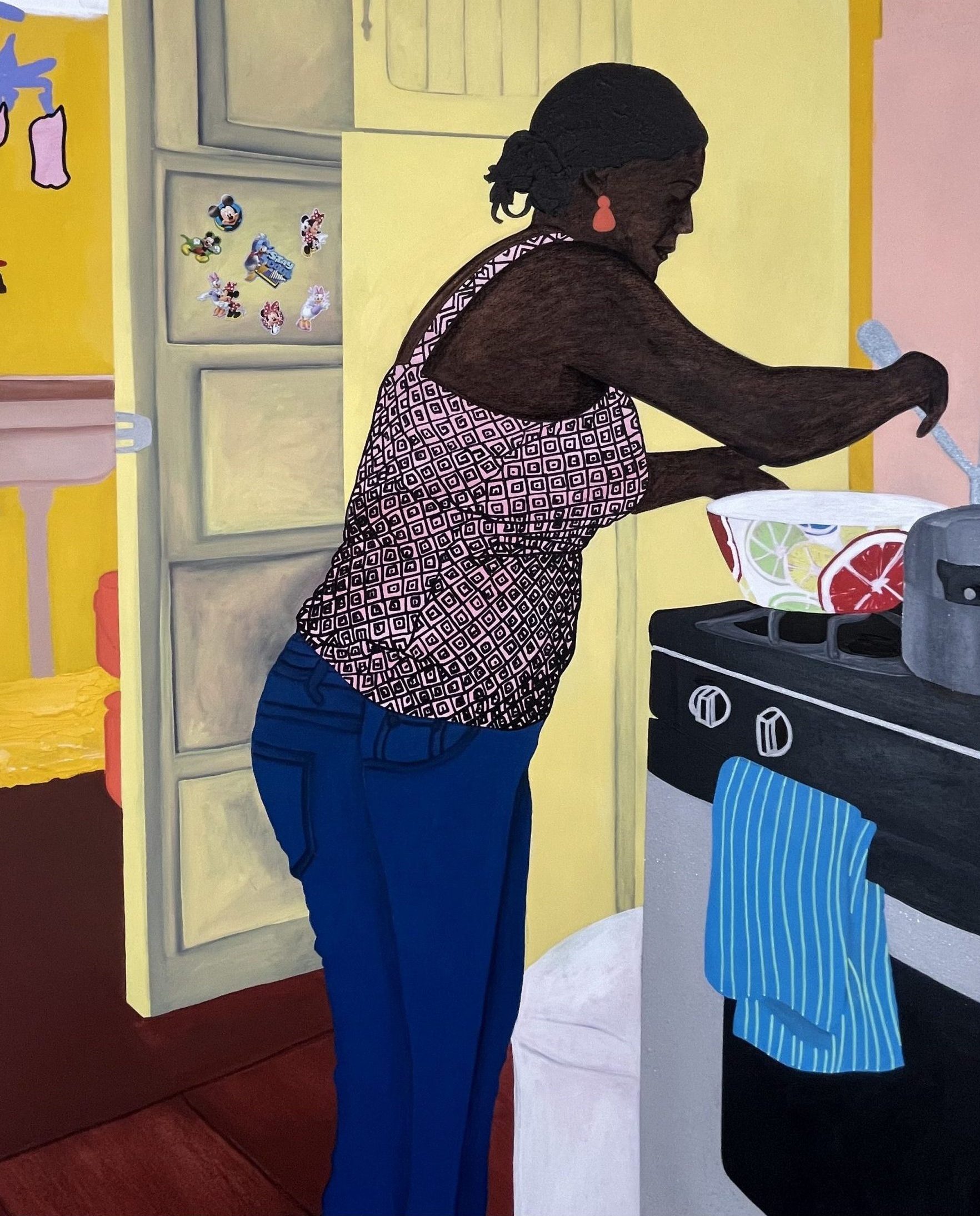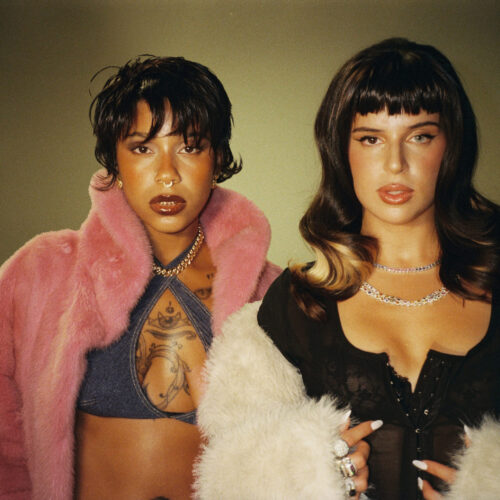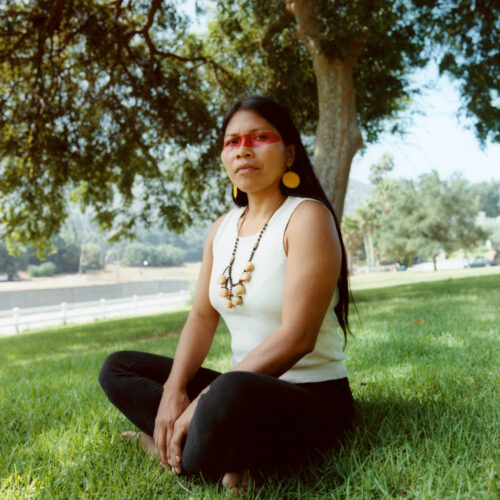Bronx-based and Dominican-American artist Tiffany Alfonseca reflects on the Afro-Latinx experience through her bold and vibrant works. As a mixed media artist, Tiffany combines acrylic paint, charcoal, and glitter for her creations, breathing life into the two-dimensional art form through texture and depth. She draws inspiration from her own background and themes present in her culture, often depicting her loved ones and objects reminiscent of her childhood. By mixing patterns, colors, and mediums, Tiffany manages to brighten those quotidian tasks like bathing or folding laundry.
Tiffany has always had an interest in art, but decided to take her work more seriously a few years back. Since then, she has had her work displayed in Gallery 1957, UNIT LONDON, and New Image Art Gallery. Last February Tiffany also curated De Lo Mío, a group exhibition at Jenkins Johnson Projects, in Brooklyn, New York, (one of a few Black-owned galleries in the city) featuring works from Bianca Nemelc, Joiri Minaya, Monica Hernandez, Uzumaki Cepeda, and Veronica Fernandez — all women of Dominican heritage. The exhibit aims to amplify the diversity in shared identities, celebrating those differences with each artist’s perspective. Now, the Bronx native is set to present her first solo exhibition, De Las Manos Que Nos Crearon, for Fall 2021 at The Mistake Room. From creating personal portraits for high-profile actor and fellow Afro-Dominican Angel Bismark Curiel to having her work featured by American Express and Planned Parenthood, she has solidified her place in the contemporary art scene. In this piece, Tiffany Alfonseca shares her insights on her most meaningful work and the inspiration behind it all.
- “Esta vez sera diferente”
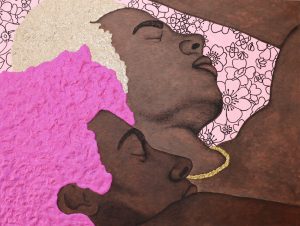
2020 // Acrylic paint, charcoal, and glitter on stretched canvas // 30×40 inches
For me this piece is a representation of Black and brown queer love, depicting how being queer can be challenging in the Latinx community and culture. “Esta vez sera diferente” stems from wanting to change the narrative of forbidden queer love and embracing it instead in the Latinx culture.
- “Si dios lo permite”

2020 // Acrylic paint, oil sticks, glitter, and charcoal on stretched canvas // 48×48 inches
Being protected and having faith in God is crucial in the Dominican culture. The Dominican Republic is the only country in the world to have an image of the Holy Bible on its flag and in general, religion plays a big role in the Latinx culture. “Si Dios lo permite” is a saying I heard often while growing up coming from my elders which translates to “If God permits” and it kind of just stuck with me.
- “La hija de Margo (Consuelo)”

2021 // Colored pencils, gouache, and glitter on paper // 30×40 inches
This painting is a part of a project that I’m doing where I’m painting old family photos. Consuelo was my grandmother from my mothers side. This photo was taken on my grandmother’s wedding day when she was 16 years old, shortly after she moved to New York City from the Dominican Republic and started a new life and family.
- “La Mathy Santana”
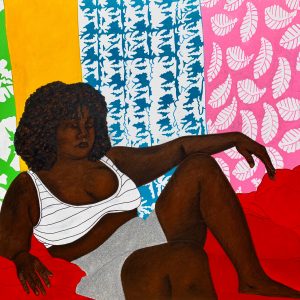
2020 // Acrylic paint, Charcoal, Oil Sticks, Paint markers, and glitter on canvas // 40×40 inches
Mathy Santana is a close friend of mine and I always admired her confidence. A big part of my practice is to pay homage to women in my life and uplift them.
- “Lata de Bustelo pa bañarse (El mundo es mio)”

2020 // Acrylic paint, Charcoal, rhinestones and glitter on canvas // 30×40 inches
Something I’ve always noticed in the Latinx culture is that we find a way to make something out of nothing, and we use almost any object and make it multi-purpose. In this case, “Lata de Bustelo pa bañarse (El mundo es mio)” sees the grandmother using an old empty can of bustelo coffee to bathe the boy.
- “No dejes que las apariencias te engañen”

2020 // Acrylic paint, charcoal and glitter on stretched canvas // 48×48 inches
Looks could be deceiving in many cases, especially when you’re a “macho straight-passing” gay man. I find that alot of Latinx men tend to be very masculine to disguise the fact that they’re queer because it’s still not 100% accepted in our culture.
- “Milady (De La Vega)”
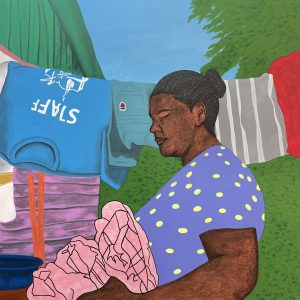
2020 // Acrylic paint, charcoal and glitter on stretched canvas // 48×48 inches
Milady is a friend of my mother’s and I captured her in this very nostalgic moment of hanging up the wet clothes outside to dry. That is something I always remembered seeing in the streets whenever visiting the Dominican Republic as a kid.
- “Bustelo pot (Still Life)”
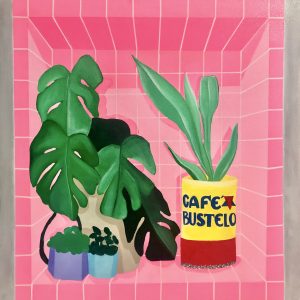
2018 // Acrylic paint and glitter on stretched canvas // 24×24 inches
Touching back on the topic of using objects and making them multi-purpose, here in this painting the bustelo can is being used as a plant holder. A lot of my work is very nostalgic and stems from memories growing up and this is always something I would see in a grandmother’s house.
- “Romi”
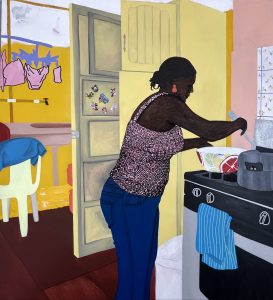
2021 // Acrylic paint, charcoal, stickers, and glitter on stretched canvas // 48×60 inches
In the Dominican Republic it’s normal to have a trabajadora in your home, and Romi happens to be my aunt’s trabajadora for years now. Every summer that I would go back to the Dominican Republic, she would always be there to welcome me with open arms.
